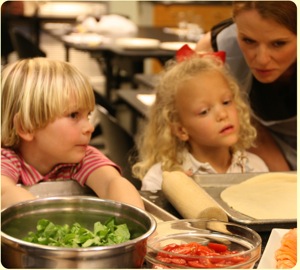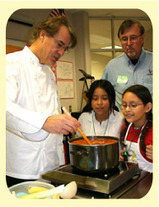Dairy:
At Recipe for Success Foundation we focus on eating plenty of fruits and veggies. But, eating healthy proteins, dairy and grains is just as important to a well balanced diet. Choosing the right dairy gives you vitamin D, Potassium and Calcium and also packs a double punch with plenty of protein. However, not all dairy products are created equal. While they all come from milk, they can be processed and flavored to be more like dessert than a healthy part of your meal. Low-fat, unflavored options are generally a better choice for milk and yogurt. Sugar-packed flavored yogurts can lack the muscle building protein and contain as much sugar as a soda! Fresh fruit adds sweet flavor plus fiber and nutrients you won't get from sugar.
Yogurt can also be a wonderful substitute for some of your favorite dips and sauces. Greek yogurt can take the place of mayonnaise in many recipes, transforming dips into rich, healthy snack. Substitute yogurt and a bit of sour cream for ranch dressing and you cut the fat and boost the protein without loosing flavor. Our yogurt based Tzatziki recipe has bright herb and citrus flavors and is a great snack with whole-wheat pita chips or veggies.
VegOut!
In celebration of National Nutrition Month, starting March 1st Recipe for Success Foundation is challenging Houstonians to VegOut! with a pledge to eat more vegetables and fruits. Take the challenge and develop a healthy habit that sticks! Expand your veggie repertoire by trying 30 different veggies and fruits; this 30 Ways in 30 Days Challenge is for everyone!
The first step is to visit www.vegoutwithrfs.org and register to take the challenge. The website is full of resources to source and prepare fresh seasonal veggies. The website includes:
· The 30 Ways in 30 Days recipe collection
· Ideas for getting kids to eat their veggies
· Downloadable veggie log (challenge entry form)
· A forum to share ideas, photos and recipes
· Links to area partners who will help you VegOut!, including restaurants featuring vegetarian options, farmers markets and grocers offering local and seasonal fresh produce, area farm and CSAs, and community gardens where you can grow your own.
As soon as the challenge begins, start eating your veggies and log them as you go. Try this tasty Rainbow Slaw recipe to knock 5 veggies and fruits off your list at once! Once the challenge is complete, turn in your log form to be entered to win a prize! Visit www.vegoutwithrfs.org for more information.
Join the VegOut! with Recipe for Success 30 Ways in 30 Days Challenge today!
Portion Distortion
Filling your plate with healthy foods may seem easy, but making sure you don't over-do it can be a challenge. Understanding how much food you should eat can be hard work when we are constantly served large portions of food. One entrée at a restaurant can be 2, 3 or more servings! Over time, this creates portion distortion. Here is a recipe to help you keep your portions in check. By using an 8 or 9-inch tortilla for Vegetable Quesadillas and loading it with veggies, you have control of your portions. Follow these simple steps to get control of your plate and see past the portion distortion:
1. Start with the Plate, then make a guide. Shrink the size of your plate to keep food quantity in check. Many dinner plates are 11-inches or more! Find a plate that is 8 or 9 inches and use it as your dinner plate. Eating out can make it hard to keep our proportions in check. Cut a 9-inch round piece of paper and map out MyPlate to fold and keep with you on the go. You will begin to notice just how big restaurant plates can be! If you don't want to pull this out at a restaurant, measure your stretched hand from pinky to thumb, tip to tip. Typically the measurement will range between 7 - 9 inches. This will give you an estimate to help gauge plate size.
2. Choose Smart, Make it MyPlate . When making your plate, start with vegetables, then fruits. Putting the vegetables and fruits on your plate first will make sure there is plenty of room for these nutrition packed foods. Then, add whole grains and lean protein to round out your meal. Think of dairy as an indulgent treat and limit it to a few ounces per meal. One ounce of cheese is about the size of two dice.
3. Plan ahead. Make a meal plan for the week and do as much of the shopping in advance as possible. Once you have the groceries at home, you are less likely to order out or pick up an unhealthy meal on the go. If you know you are dining out, check the menu in advance and make choices before you arrive to the restaurant.
4. Slow Down & Don't Get Stuffed. Take your time at every meal and enjoy the food and the company around you. This is the fuel to your body and your life and not something to be rushed through. It may feel weird at first, but chew slowly and put your fork or spoon down between each bite. The more you practice the more natural it will feel. It takes our stomach about 20 minutes to tell our brain we are full, so eating too quickly can cause you to over eat. Forget about the clean plate club. Once you slow down and take your time, notice what it feels like to be full and satisfied, not stuffed to the brim. After a healthy meal you should feel energized, not full and sluggish.
5. Drink Water. All day. Staying hydrated will help you understand when you are truly hungry and truly full. Thirst can sometimes be mistaken for hunger, so make sure to have a glass of water before, during and after your meal.
6. Have fruit for dessert. If you crave something sweet after your meal, save the fruit for dessert. Fruits like watermelon and pineapple are just as sweet as candy but pack an extra vitamin punch.
Making Substitutes to Recipes
Getting comfortable with making substitutions in recipes is a great way to keep
cooking interesting, fresh, healthy and seasonal. Take, for instance, our 1-2-3 Salad
recipe- one of our most popular dishes. It isn't popular because of the specific
ingredients or flavor combinations, but because of how UN-specific it is! This salad is a
template for you to mix flavors, textures and colors using a variety of fresh, seasonal
harvest. Rather than calling for 1 cup of almonds, it simply says "1 cup nuts or seeds".
There are so many possibilities! Don't let this intimidate you; even the most rigid recipe
follower can make simple substitutions. Start by thinking about a rainbow of color in
your next salad. Start with a bed of greens, instead of lettuce, consider incorporating kale,
swiss chard or spinach, all greens that are in high in vitamins and fiber and in season
right now. Layer on more color, texture and flavor by tossing in some diced and roasted
butternut squash and a handful of pomegranate seeds. The bright contrast of colors will
make for a beautiful harvest dish. Your creative juices will start flowing when you begin
to experiment the different flavor combinations. Think of each recipe as a basic guide
and make it your own by mixing it up with what is seasonal and fresh! Try this delicious
vinaigrette recipe, make it in a jar and store it in the refrigerator for easy salad dressing
during the crazy holiday season!
Pomegranate Vinaigrette
2 Tablespoons Pomegranate Molasses
1 garlic clove, minced
1 lemon, juiced
¼ cup grapeseed oil, walnut oil, or extra virgin olive oil
Salt and Pepper to taste
Combine all of the ingredients in a jar, tighten the lid, and shake to combine. Taste and
adjust salt and pepper.
What is the best way to get my kids interested in cooking?
Chef Kendall's ideas for introducing your children to meal preparation:
- Get your children interested by involving them in the planning process.

Choose recipes, make shopping lists, and go shopping together. - Make your kitchen kid friendly.
Bring in a stool or chair so that the cooking area can be reached by your children; use non breakable measuring cups and bowls; have cooking utensils that are easy for them to manipulate, like a plastic serrated knife, small whisk, spatula, and spoon. - Read the recipe together.
This will give you an opportunity to reinforce math and measurements, and organize all of your ingredients and tools. - Work through the recipe together step by step.
This will reinforce the importance of following directions in order and will allow your children to ask questions along the way. - Have fun and get your hands dirty.
Avoid getting upset if the recipe doesn't go exactly as planned, have fun with it, the important thing is that your cooking together. Let your children get their hands dirty by doing tasks like kneading dough, etc.










Dear Emmy,
First step is to involve them in the process of selecting and preparing meals. A great place to start with veggies is on a pizza, but one you let the kids help make. They get to put something they already love on it (corn?), if they agree to try something new, like maybe kale or spinach. Watch our site for recipe and ideas to engage your kids in cooking!
Chef Molly
Dear Chef,
What are some creative ways for me to get 9 yr old and 12 yr old boys to even begin to like any vegetables? They do not like any vegetables at this point except for corn... Please help!
Thanks,
Emmy